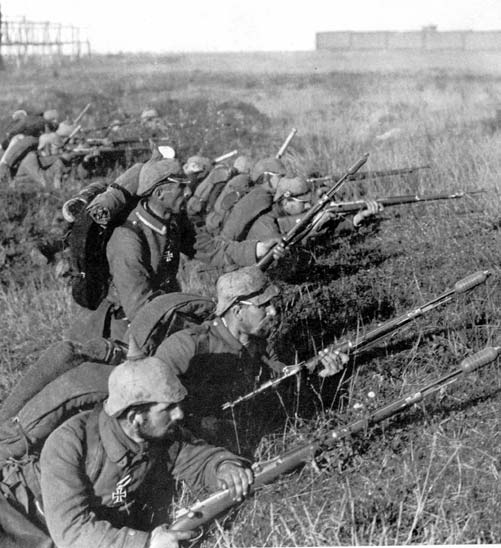Huard's book complements Aldrich's book in several important ways. Both books concerned the Battle of the Marne in September 1914, but their differences create a broader picture of that significant battle:
- Aldrich lived about 30 miles east of Paris and Huard lived about 60 miles east of Paris.
- Aldrich lived on the south side of the Marne River and Huard the north.
- Aldrich was able to stay in her home while Huard was forced to leave.
- Aldrich was single. Huard was married and very concerned about her husband Charles after he was called into battle.
You see people try to hold on to their current location as long as possible before they are forced to move to a safer place, both when they are at home and in temporary locations. People had to quickly decide what was most important to their continued survival.
 |
| German soldiers, Battle of the Marne |
Huard was a well-known writer of fiction and nonfiction, including magazine articles about life in France. The book has a novel-like flow. You feel like you are in the middle of frantic evacuations from villages and other stressful ripple effects of war.
My Home in the Field of Honour was illustrated by Huard's husband Charles, who became the Official Painter to the Sixth Army of France. Charles' drawings have a distinct impressionistic style that brings both emotion and realism to what is portrayed.
The wartime responsibilities of medical workers are described in My Home in the Field of Honour. Huard's château in Villiers was converted into a hospital before the area was later overrun by German soldiers.
You see how medical workers had to learn quickly on the job. After her home is converted into a hospital, Huard is greatly helped by a nurse identified as Madame Guix, who emerges as a quiet heroine of the book. Madame Guix used cut-up linen from Huard's home to train people in bandaging:
Half a dozen hands were left out as models and it was with these that Madame Guix commenced her demonstrations. She soon put her listeners at ease, and presently all were anxious to try a hand at bandaging. The naive clumsiness of these poor souls was extremely pathetic, but such was their patriotism that they never considered themselves ridiculous for a single instant, and stood there fumbling the long linen rolls with hands that were far more accustomed to wielding a spade or directing a plough.When Huard returned to her home after the German army retreated, she was confronted with appalling examples of the savage fury and senseless waste of war. Her home had been used as headquarters for the German general Alexander von Kluck.
When the Germans left her home, they stole everything valuable and vandalized much of what was left. As Huard delicately put it, even though though their château had "all modern sanitary conveniences, these were purposely ignored, and corridors and corners, satin window curtains and even beds, were used for the most ignoble purposes."
But Huard's home was restored to its use as a hospital, with one hundred beds providing care "for all those of France's brave sons who have come to us, sick or wounded."
Huard promoted My Home in the Field of Honour in the United States in early 1916 with a lecture titled "My Year Among the Fighters."
Like Mildred Aldrich, Frances Wilson Huard continued to write books during the war, including My Home in the Field of Mercy (1917) and With Those Who Wait (1918). Huard lived near Château-Thierry, the scene of a significant battle between the United States and Germany in 1918.
My Home in the Field of Honour was published around May 20, 1916, when an advertisement for the book appeared in The New York Times. Front page headlines that day in The New York Times included:
- URGE RETRIBUTION FOR THE LUSITANIA / Memorial Meeting Speakers Demand That America Join War Against 'Nation Gone Mad.' / SEE OUR IDEALS AT STAKE / Must Fight for Our Lives if Germany Wins—Americans Declared Not Neutral at Heart.
- BEAT ITALIANS BACK ON 5-MILE FRONT / Big Austrian Guns Force Withdrawal of Foe Between Monte Maggio and Astico Valley. / OTHER POSITIONS GIVEN UP / Berlin Estimates That the Austrians Have Pushed Ahead Five Miles at Some Points.
Online versions:
Newspaper information from Newspapers.com (https://www.newspapers.com/)
Photograph by German Army (http://www.greatwar.nl/germany/marne.html) [Public domain], via Wikimedia Commons
No comments:
Post a Comment